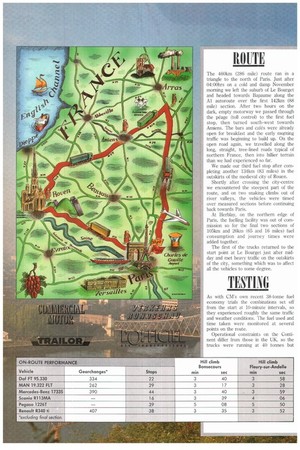TESTING
Page 22

Page 23

If you've noticed an error in this article please click here to report it so we can fix it.
As with CM's own recent 38-tonne fuel economy trials the combinations set off from the start at 10-minute intervals, so they experienced roughly the same traffic and weather conditions. The fuel used and time taken were monitored at several points on the route.
Operational constraints on the Continent differ from those in the UK, so the trucks were running at 40 tonnes but speed is restricted to 80km/h (50mph) on motorway-standard roads and two-lane A roads. French trailer manufacturer Traitor provided all six entrants with identical versions of its latest 13.5m air-suspended, tilt-bodied, Maxicube semi-trailer.
Before leaving the assembly point at Le Bourget to fuel up at the initial service area, each vehicle was weighed to verify uniformity. the job of fueling accurately was simplified by the use of specially adapted tanks on each truck. A long centrally mounted filler ensured that any trapped air was vented and the fuel could be added precisely to a predetermined mark. The procedure was repeated three times around the route at the end of each stage and once more back at the start point.
Each vehicle was driven by a company driver, but with a journalist from one of the three magazines acting as an observer, recording journey and hill-climb times, noting the amount of fuel added at the stops and counting the number of gearchanges.
All six vehicles were equipped with a Kienzle tachograph and tape recorder. Computer analysis of the tape by Kienzle provided us with a performance profile indicating the percentage of running time spent within defined road speed and engine speed bands (as shown on the opposite page). This together with information recorded on the tacho discs provides the basis of our comparison.




















































